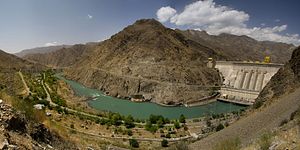Kyrgyzstan is celebrating its independence today. On Friday, President Almazbek Atambayev declared the country energy independent with the opening of a new power transmission line. The Chinese-financed project may help Kyrgyzstan cut the cost of transmitting electricity within the country, or at the very least give Kyrgyz greater control over the transmission, but true energy independence will remain elusive.
At the inauguration of the new transmission line, Atambayev said, “We are witnessing a historic event. Kyrgyzstan has secured energy independence,” he said. “We had to ask our neighbors for transit. Now, nobody will turn off our power.”
The Datka-Kemin transmission line enables Kyrgyzstan to transmit electricity from the Datka substation in southwestern Kyrgyzstan to a new substation in Kemin, in the northeast, without routing through Uzbekistan as older infrastructure did.
On August, 31 1991, Kyrgyzstan became the first Central Asian state to declare independence from the crumbling Soviet Union. The Soviet Union, which delineated the borders of Central Asia in the 1930s, installed a power grid that largely ignored them. Southern Kyrgyzstan supplied electricity to Uzbekistan and northern Kyrgyzstan was supplied via lines originating in Kazakhstan. While this made sense geographically, it ceased to be prudent when the countries split politically. The Datka-Kemin line corrects some of the problems that came with independence–namely the need to pay Uzbekistan to transmit Kyrgyz energy from one corner of the country to the other.
According to Bekbo Mamatbekov, Chairman of National Electric Network of Kyrgyzstan JSC, the new transmission line will save Kyrgyzstan $8-9 million annually in transit fees.
But the project–a 405-kilometer transmission line and the new substation in Kemin–cost $390 million, paid for with a loan from the Import-Export Bank of China and constructed by a Chinese company, Tebian Electric Apparatus Stock Company (TBEA). At least one Kyrgyz parliamentarian expressed concern about the project, Ahmatbek Keldibekov of the nationalist Ata-Jurt party was quoted by the Vecherny Bishkek newspaper in 2012 as saying, “There is no doubt that this project is indispensable. But since we are taking out credits, there should be a tender. China is giving credits at 2 percent per annum and then obliging us to use its subcontractor…We need to bring in other foreign companies to the tender and choose the one that offers the best price.”
Atambayev’s grandiose statements aside, Kyrgyzstan is a long way from complete energy independence. First, with regard to electricity, this summer Kyrgyzstan imported electricity from both Kazakhstan and Tajikistan. Tajikistan, which pressed for a price hike, agreed to supply Kyrgyzstan with 500 million kWh of electricity from June to September. The need to import electricity from Tajikistan had less to do with transport infrastructure than shortages due to environmental factors. Low levels at the Toktogul reservoir prompted Kyrgyzstan to look to its neighbors.
Then there is the issue of gas. Last year, Russia’s Gazprom took over KyrgyzGaz, the state gas supplier, for a symbolic $1. Gazprom also took on KyrgyzGaz’ $40 billion in debt and in the process irritated Uzbekistan–which cut gas supplies to southern Kyrgyzstan for nearly nine months, only resuming flows in December 2014. This is also a Soviet-era infrastructure problem. Kyrgyzstan does not have significant gas deposits of its own and must import, but southern Kyrgyzstan is linked to pipelines in Uzbekistan and the north to Kazakhstan–the two are not linked together. So while Gazprom can ensure supply to northern Kyrgyzstan, until new pipelines are built it cannot supply southern Kyrgyzstan.
Atambayev declared energy independence Friday at the Datka-Kemin inauguration and then highlighted Kyrgyzstan’s dependence on Russia–announcing that Gazprom would be investing $700 million in gasifying 60 percent of Kyrgyzstan. According to Kabar, Atambayev said that “As part of the strategic partnership with Russia all regions of the republic will be supplied with gas by Russia’s Gazprom.”

































